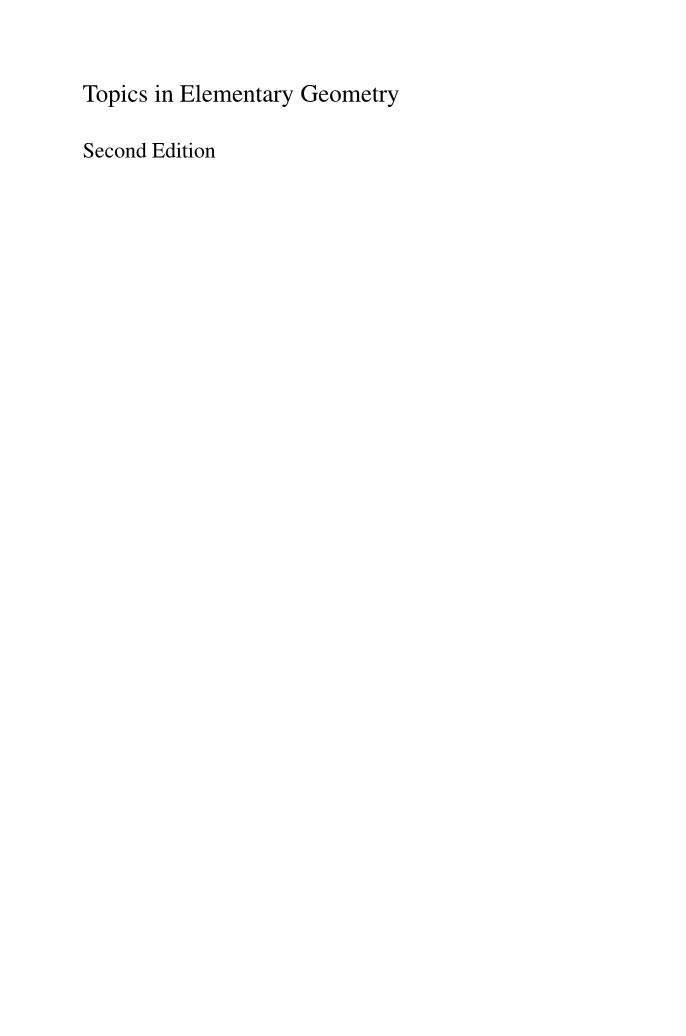Topics in Elementary Geometry
——The Pythagorean Theorem
原文作者 Reinie Erne acute; Second Edition
摘要:勾股定理不仅是最重要的和古典几何,它也很有名,你甚至可能专业。这是由于它的简单性,但并不意味着提高证据是显而易见的。直角三角形的定理指出 ,a2 b2 = c2的关系。欧几里得的元素,伟大的希腊文化的纪念碑,包含一个系统论述和严格的逻辑建造飞机的数学特性
关键词:毕达哥拉斯定理; 数形结合;勾股定理;
外文文献出处:Second Edition
1.1
勾股定理不仅是最重要的和古典几何,它也很有名,你甚至可能专业。这是由于它的简单性,但并不意味着提高证据是显而易见的。直角三角形的定理指出 ,a2 b2 = c2的关系。于几何术语来说,这句话就变成:广场的面积等于有一边的两个正方形区域的总和,具有复合的另一个腿三角形的一边。罗马哲学家毕达哥拉斯的定理名萨摩斯。大约公元前500年。他是否意识到定理,如果是这样的话,他是否和他的追随者的证明,不能肯定地说。然而,似乎已经几个世纪之前,熟悉定理。整个时代,许多不同类型的证据得到定理,我们这里现在他们四个。
1.2
考虑以下三个属性:(1)相应的距离数据比例,(2)的面积图可以看作三角形的面积,为曲面图应该取而代之的是金额的上限,(3)简洁地说,三角形的面积等于两个长度的产物。它遵循从这些领域的两个相似的数据比例相应长度的广场。这意味着勾股定理可以在更广泛的意义上说:如果在一个直角三角形,我们设置三个相互类似的数字领域的腿和一个直角三角形的斜边,这样的地区的前两个等于第三的面积。事实上,这样一组立即出现了绘制高度CD;三角形的出租车,DAC,该银行是相似的,因为他们有一致的角度(图1.1)。
1.3
欧几里得的元素,伟大的希腊文化的纪念碑,包含一个系统论述和严格的逻辑建造飞机的数学特性和。直到现代的外观19世纪下半叶的批评,它仍然是一个完美的古典数学论证的例子。该缺陷发现前几代经常被误解的品质。可以找到我们的定理。它证明了如下(图1.2):我们扩展高度CDK,其次是AE,CG和CH。三角形工厂和CAG全等,因为他们有两个等边的夹角。第一个区域三角FAC相同,相同的基FA和相同的高度,和第二个三角形KAG,类似的原因。由此可见,广场ACA F与矩形ADKG相同的区域。同样地,广场的面积BCB E等于长方形BDKH领域。
1.4
如果ge;b,我们设置三角形在广场一侧c在四个位置上获得通过旋转直角的中心广场(图1.3),这四个数字不重叠和填满广场,广场的长度minus;b。因此,我们的差别
这个证明可以在古印度数学家的工作毗迦(ca 1100)(底部钻具组合),(卡扎菲),但是根据历史学家康托尔,这是已知的印第安人几个世纪前基督
1.5
点E、C、F(图1.4)似乎躺在一行上,外部的平分线
角c .我们还画出内部平分线的CD,位于垂直于它,GA扩展到K,L HB,EA M,N FB,并绘制议员向和垂直于CD。简单的参数与全等三角形,这仍然需要制定必要的护理,表明三角形表示与图中的相同数量相等的区域。立即定理的正确性。图就显得更为惊人,因为ABCitself分成块,全等三角形部分2和3,分别。三角形的区域1、2、3和4,分别
兹证明于1906年由爱泼斯坦。这种解剖证明并不新鲜,另一个著名的例子就是证明Thabit伊本Qurraacute;,由an-Nairizi写了一个阿拉伯语的评论员的元素。当一个lt; b,广场a2分为两个三角形和四边形,和广场b2三角形和四边形,之后,我们只需要将五件获得的封面广场周围c2。
1.6
毕德哥拉斯定理的证明,包括一些由已知的数学以外的男人,就像作家Multatuli Mul(529年的想法),和美国总统加菲尔德(Garf),如此之大,collec这样的证据已经出版。因此没有巧合,这个定理作为努力的起点比较给定几何定理的证明彼此为了建立客观标准来衡量的简单证明。例如,使用的次数,现有的定理可以作为衡量。然而,这样的观察发现没什么兴趣,可能由于ar bitrariness选择标准。此外,这证明的问题是最简单的心理之一似乎是比数学性质之一。类似的观察有关几何结构的简单性对于一个给定的图发现更多的支持。尽管反对仍然是相同的,减少随意性,因为限制的允许struments,统治者和指南针。此外,在技术图纸的情况下,经济因素也发挥了作用。这可能是一个原因的关注geometrography莱莫恩(1888)(Lem)。
附外文文献原文
1.1
The Pythagorean theorem is not only one of the most important and oldesttheorems in our geometry, it is also very well known and you might even saypopular. This is due to its simplicity, which nonetheless does not imply thatits proof is obvious. The theorem states that, for a right triangle with legs oflength a and b and hypotenuse of length c, we have the relation a2 b2 = c2. Inmore geometric terms, this statement becomes: the area of a square having thehypotenuse as a side is equal to the sum of the areas of the two squares, eachof which has one of the other legs of the triangle as a side. The theorem takesits name from the semi-legendary philosopher Pythagoras of Samos wholived around 500 BC [Hea2]. Whether he was aware of the theorem, and if so,whether he and his followers had a proof of it, cannot be said with certainty.However, it appears that already many centuries prior to this, the Babylonianswere familiar with the theorem. Throughout the ages, many different proofsand many different types of proofs have been given for the theorem; we present four of them here.
1.2
Consider the following three properties: (1) corresponding distances in twosimilar figures are proportional, (2) the area of a figure can be viewed as thesum of areas of triangles; for a curved figure this should be replaced by thelimit of a sum, and (3) said succinctly, the area of a triangle is equal to the product of two lengths. It follows from these that the areas of two similar figures are proportional to the squares of the corresponding lengths. This implies that the Pythagorean theorem can be stated in a broader sense: if on the sides of a right triangle, we set three mutually similar figures with areas the legs and the hypotenuse of a right triangle, such that the sum of the areas of the first two is equal to the area of the third. In fact, such a set immediately appears by drawing the altitude CD; the triangles CAB, DAC, and DCB are similar, because they have congruent angles (Fig. 1.1).
1.3
Euclidrsquo;s Elements (ca. 300 BC) [Hea1], that great monument of Greek culture, contains a systematic exposition and rigorous logical construction of the mathematical properties of the plane and of 3-space. Until the appearance of the modern criticism of the second half of the nineteenth century, it remained a faultless classical example of a mathematical argumentation. Supposed imperfections found by earlier generations often turned out to be misunderstood qualities. Our theorem can be found in the 1st Book as Proposition 47. It is proved as follows (Fig. 1.2): We draw the extended altitude CDK, followed by AE, BF, CG, and CH. The triangles FAB and CAG are congruent because they have two equal sides with congruent included angle. The first one has the same area as triangle FAC, which has the same base FA and the same height, and the second one has the same area as triangle KAG, for a similar reason. It follows that square ACAF has the same area as rectangle ADKG. Likewise, the area of square BCBE is equal to the area of rectangle BDKH.
1.4
If a ge; b and we set the triangle in a square with side c in four positions obtained from one another by rotation over a right angle about the center of the square (Fig. 1.3), the four figures do not overlap and fill the square up to a square with sides of length the difference a minus; b. We therefore have
or, after simplifying,
This proof can be found in the work of the ancient Indian mathematician Bhaskara (ca. 1100) [Bha], [Col], but according to the historian Cantor, it was already known to the Indians some centuries before Christ [Can], see also [Gard]
1.5
The points E, C, and F (Fig. 1.4) seem to lie on one line, the external bisector
of angle C. We also draw the internal bisector CD, which lies p
剩余内容已隐藏,支付完成后下载完整资料
英语原文共 135 页,剩余内容已隐藏,支付完成后下载完整资料
资料编号:[287074],资料为PDF文档或Word文档,PDF文档可免费转换为Word
课题毕业论文、外文翻译、任务书、文献综述、开题报告、程序设计、图纸设计等资料可联系客服协助查找。




